Tom Hamiltons Impact On Composite Homebuilts By David Gustafson
| Though he’s spent the last two decades designing missiles for the Navy, the Kodiak for Quest Aircraft and has become the world leader in composite float production, Tom Hamilton still stands out in the homebuilt community for what he accomplished with the Glasair and GlaStar series of airplane kits. Tom is one of a handful of highly talented aeronautical types who appeared at the right time with the right product in a movement that was experiencing geometric growth. Tom’s talents with a pencil and slide rule, along with his youth and entrepreneurial spirit led to a high volume of kit sales.
Tom had entered the University of Washington with an interest in business. He received a degree in this and went into the science side of the school for dentistry. After working a year and a half as a volunteer in a dental clinic, he realized “that clearly wasn’t what I was being called for”, and he switched over to aeronautical engineering in a non-matriculating manner under two professors and the top graduate student at the school. “I studied specifically for designing aircraft that I could end up flying. Following some wind Tom Hamilton with the original Glasair I, down on the pig farm. tunnel tests at the University, my dad was gracious enough to let me start the building process in his garage.” It was an all composite aircraft that introduced Tom to the basics of vacuum bagging. He bolted a Lycoming 0-235 on it.
Tom’s intentions were to fly his creation and then put it into production as a homebuilt kit.
Between the idea and the reality however, there were some issues. “Looking back on it, it was very,
very crude…but it was a molded airplane.” He had spent two years building the aircraft by himself. “I
made the first flight at Arlington and scared myself to death! I made a few changes to the airplane and
then realized that I was playing with fire. It was a two-place tandem and had to be flown solo from the
rear seat which made it a challenge to land because it was blind over the front. So I changed it from a In the two years that had elapsed since he’d started on his first concept, composites had
gone through a lot of changes and the processes for laying up fiberglass structures had improved
dramatically. Tom decided to try again. This time he recruited one of his friends from the dental
program, Ted Setzer, and the two of them began work on the Glasair I. Tom’s brother, Steve, assisted The design focused on two seats, in side by side configuration with a low wing. Tom molded
a canopy based on his own (short) height and would later add three inches to the top of the canopy.
That first Glasair was fitted with the 0-235 from Tom’s first airplane and it flew at nearly 200 mph! He started out with flaperons, but later changed to ailerons and flaps. The real pioneering with the Glasair
was in the use of “sandwich” construction. Tom built female molds for outer surfaces of the aircraft. Once
the layups for the outer surfaces were cured, he laid in a sheet of foam and covered that with another
layer of fiberglass. The vacuum bagging brought the foam and second layer of glass up against the curve
of the outer layer. Burt Rutan had chosen to go without molded parts, by laying glass over a male part
that was carved out of solid foam with a hot wire. That process was quick and easy, but it required a lot Tom’s sandwich construction had a smooth surface and the skins had a gap between the upper and lower parts of the wing, providing ample room for fuel. Composite sandwich ribs were installed to maintain the shape of the wing, but at much wider spacing than is found in a wood wing structure. Homebuilders had never seen anything like it. The plane was first flown in 1979 and was then taken to Oshkosh ’80. “We came in like the bunch of kids we were, not knowing what we were getting into. My wife was pregnant and sat in a lawn chair while I did continuous circuits taking people around the fly-by pattern. When the week was over, she had written up a hundred orders for kits. We left there wondering: ‘What are we going to do now?’” They went back to the pig farm, knowing it was time to upgrade their facilities. The woodburning stove they relied on for heat was slow to get going, especially with green wood. The walls of their shed/shop were covered with plastic sheets and not nearly good enough to bring the temperature up to what they needed for curing fiberglass resin, especially a hundred orders. So with the deposits they had and the prospects they developed, they moved north to Arlington. Tom then recruited some other people along with his younger brother, Bruce Hamilton, who today runs Stoddard International, a composites company that employs about 65 people. As they launched into the kit business in 1980, Tom went to a new canopy that was 3” higher and he swapped out the engine for 150hp. A year later, Tom flew a newer version with a retractable, tricycle landing gear and 160 hp. He was getting 198 mph on 5.9 gph. He also realized that with the speed he was getting, he needed to graduate to a constant speed prop. “The effect was tremendous. Visibility on landing was dramatically improved as was crosswind handling.” Then one of his customers converted his kit to a fixed tricycle gear and Tom began offering that version as well in 1985.
Before the IIS, in 1985, Tom flew the Glasair III. No, it’s not a mix-up in the sequence. It was
called the Glasair III because it flew with 300 hp and went 300 mph, making it one of the fastest homebuilts on the market. It was basically a steroid version of what they had in the Glasair I. “We were a Shortly after the IIS flew, Tom
sold the company to his employees and
the name of the company changed from
Stoddard Hamilton to Glasair. When sales
Glasair was also the first company to utilize a
punch press for the aluminum surfaces on the GlaStar.
They pioneered the process for providing wing and tail
skins with rivet holes that were perfectly placed and
aligned with the ribs they attached to. The Sportsman 2 + 2 came later. Ted Setzer and his brother, Tom, did the Sportsman as an upgrade to the GlaStar. There were three majorimprovements. The fuselage was extended to increase the baggage area and give it the option of two additional seats and a cargo door was added. The flaps, which had been very heavy to handle were substantially lightened up. Tom was done at that point with homebuilding. He moved on to missile work and to design an alternative to Cessna’s Caravan, the Kodiak aircraft, then set up a company to manufacture certified composite floats. He looks back on it all with
an amused sense of nostalgia. The
early days were Today, Glasair is still running strong with their revolutionary “Two Weeks to Taxi” program. Blessed by the FAA, the process takes the builder from a Sportsman 2 + 2 kit to an aircraft that is ready to taxi in 14 days. It still needs finishing work, but most builders have the aircraft completed in three months. Glasair kits are still being sold, though not as frequently as they used to be. For more information visit glasairaviation.com.
|


 In his young days, Tom developed a passion
for competitive water skiing and his skill in
the sport made him a leading figure in the
Pacific Northwest. When one of his colleagues
suggested he try hang gliding, while that
movement was still in its infancy in 1971,
Tom didn’t hesitate to take up the challenge.
This was back in the days of primitive delta
wing kites. The experience of primordial
flight, coupled with the occasional rides in his
father’s Cherokee, was inspiring Tom with the desire to get a pilot’s license. He came across a Luscombe 8-D
that had been sinking into the mud on a grass strip beside Martha’s Lake and offered the owner $1,600 for it.
The owner took the offer and Tom, who was 20, began a restoration. He did his flight training in that aircraft,
wrung it out through aerobatics and assumed that all airplanes were as easy to fly as the Luscombe. That
would have a bearing on his design work.
In his young days, Tom developed a passion
for competitive water skiing and his skill in
the sport made him a leading figure in the
Pacific Northwest. When one of his colleagues
suggested he try hang gliding, while that
movement was still in its infancy in 1971,
Tom didn’t hesitate to take up the challenge.
This was back in the days of primitive delta
wing kites. The experience of primordial
flight, coupled with the occasional rides in his
father’s Cherokee, was inspiring Tom with the desire to get a pilot’s license. He came across a Luscombe 8-D
that had been sinking into the mud on a grass strip beside Martha’s Lake and offered the owner $1,600 for it.
The owner took the offer and Tom, who was 20, began a restoration. He did his flight training in that aircraft,
wrung it out through aerobatics and assumed that all airplanes were as easy to fly as the Luscombe. That
would have a bearing on his design work.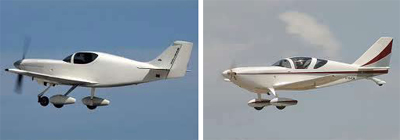
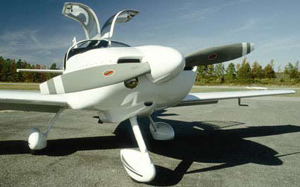 “What I began to realize was that not everyone was ready to handle a high performance
airplane. I just assumed that everyone
can fly a high performance airplane.”
In that sense Tom was a lot like Dick
VanGrunsven and his RV-3. Both had the
talent and skills to fly high performance
and both thought everyone else could
do the same thing. They wanted
the high speed, quick response and
maneuverability. Consequently their
initial designs were tailored to what they
could do, instead of to what the vast
majority of pilots out there can do.
As a result, Tom, like Dick before him, began to detune the aircraft. He extended the fuselage of the Glasair I
in both directions to increase the gear coupling and to give the elevator a slightly more docile effect. The new model
designation was the Glasair IIS. It was made available as a taildragger, retractable tricycle and fixed tricycle. The first
IIS flew in 1990.
“What I began to realize was that not everyone was ready to handle a high performance
airplane. I just assumed that everyone
can fly a high performance airplane.”
In that sense Tom was a lot like Dick
VanGrunsven and his RV-3. Both had the
talent and skills to fly high performance
and both thought everyone else could
do the same thing. They wanted
the high speed, quick response and
maneuverability. Consequently their
initial designs were tailored to what they
could do, instead of to what the vast
majority of pilots out there can do.
As a result, Tom, like Dick before him, began to detune the aircraft. He extended the fuselage of the Glasair I
in both directions to increase the gear coupling and to give the elevator a slightly more docile effect. The new model
designation was the Glasair IIS. It was made available as a taildragger, retractable tricycle and fixed tricycle. The first
IIS flew in 1990.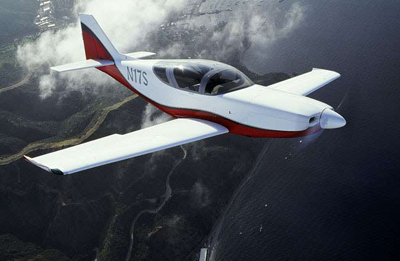
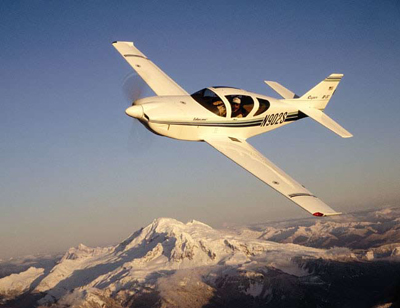
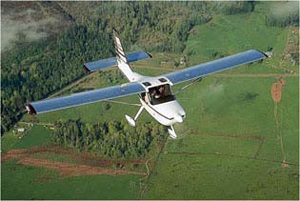 The idea was to make it as builder-friendly as possible.”
They succeeded. The company sold 1,450 Glasair kits and
1,250 GlaStar kits.
The idea was to make it as builder-friendly as possible.”
They succeeded. The company sold 1,450 Glasair kits and
1,250 GlaStar kits.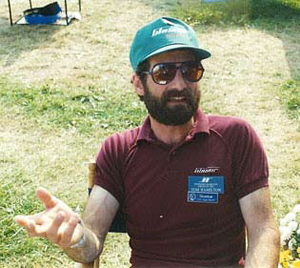
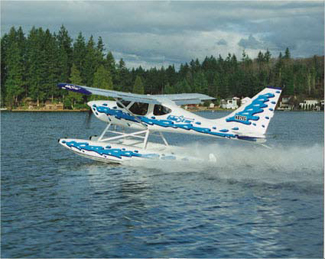 wild and crazy.
During Ted Setzer’s first flight in the
Glasair I, he bounced the airplane
off the roof of a semi truck on final
approach (the runway threshold was close to I-90). They kept shotguns near every door in the shop to drive
animals off the runway at the pig farm. Ted decided one day that he’d answered enough questions about
Tom’s first, unsuccessful design and took it out and burned it…without consulting Tom. Frustrated by the time it took to heat up the shop with green
firewood, Tom once threw in a bunch of
avgas he’d drained from Ted’s Cessna 120.
He blew
wild and crazy.
During Ted Setzer’s first flight in the
Glasair I, he bounced the airplane
off the roof of a semi truck on final
approach (the runway threshold was close to I-90). They kept shotguns near every door in the shop to drive
animals off the runway at the pig farm. Ted decided one day that he’d answered enough questions about
Tom’s first, unsuccessful design and took it out and burned it…without consulting Tom. Frustrated by the time it took to heat up the shop with green
firewood, Tom once threw in a bunch of
avgas he’d drained from Ted’s Cessna 120.
He blew 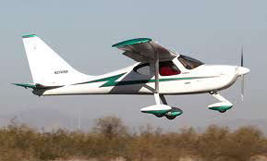 the doors and stovepipe off the
stove. Fortunately no one got hurt. They
filled in indentations in the floor of the shop
with epoxy resin. They were young, high
spirited, ambitious and totally committed to
fun flying.
“I think homebuilding is wonderful. It’s a great testimony to the good things in people. You learn,
you stay out of trouble, you can be around other people who are doing the same thing and you can enjoy
a tremendous return on your investment. I’ve never run into another homebuilder who isn’t good to be
around.”
the doors and stovepipe off the
stove. Fortunately no one got hurt. They
filled in indentations in the floor of the shop
with epoxy resin. They were young, high
spirited, ambitious and totally committed to
fun flying.
“I think homebuilding is wonderful. It’s a great testimony to the good things in people. You learn,
you stay out of trouble, you can be around other people who are doing the same thing and you can enjoy
a tremendous return on your investment. I’ve never run into another homebuilder who isn’t good to be
around.”